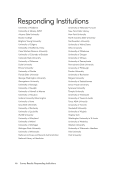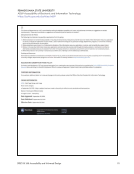6 Survey Results: Executive Summary Universal Design & UDL Universal design is still an emerging area of focus in libraries. Thirty-five institutions, representing just over half of the respondents, stated that their staff had received training on universal design principles. Of those, twenty-six stated that this training had come from attending events, such as conferences and symposia. Considering universal design principles during projects remains inconsistent a majority of respondents reported that these principles are only sometimes considered in all settings. However, it is clear from the comments to both these questions and a question about how accessibility is integrated into the institution’s collection development policies and procedures that some libraries are incorporating universal design principles into their processes. Universal Design for Learning (UDL) is still not common in library instruction settings. It is particularly uncommon in for-credit courses taught by library staff and in settings outside of traditional library instruction to incorporate UDL principles. But, even where it is applied, the majority of respondents said that it was only sometimes incorporated into their daily work. Interestingly, video tutorials are the type of instructional setting where Universal Design for Learning is incorporated most frequently. Six respondents said that it is always incorporated into their video tutorials and another 33 said that it is sometimes applied in this setting. Conclusion The results of this survey give insight into how ARL member institutions address accessibility services and what technologies and services they support. By asking for updated information on some of the areas explored in SPEC Kit 321, this survey allowed us to identify how work in this area has changed, best practices that have emerged, and issues that still remain in this arena. Additionally, we expanded on the information gathered in SPEC Kit 321 by including questions related to new areas of interest, including the degree to which libraries have applied the principles of universal design and accessibility in developing their spaces, services, and practices. This updated information can help institutions who are developing their own accessibility practices and benchmarking their work against the work being done at peer institutions. A few recommendations emerged from the respondents’ comments. • Make sure service desk staff are trained in accessibility issues and related library services as this is the primary point of contact for users with disabilities. • Develop strong relationships with offices/departments on campus who serve students with disabilities collaborate as needed. • Advertise available services through all mediums in various locations on campus. • When recruiting candidates, consider what you provide to candidates (questions prior to interview, questions about dietary restrictions, information on any transportation options) this sends the message that “We care about accessibility issues.” • Make sure to offer a mix of spaces (individual and group) that are accessible and offer assistive technologies (for example, carrel spaces). • Be proactive consider what you are not doing and think about how you can identify and respond to unmet needs, such as involving patrons with disabilities in ongoing user experience testing and other decision making activities. • Consider what assistive technologies and other tools/devices you can lend. This can range from loaning out laptops with assistive software to offering the options to check out specialized equipment such as lights and accessible hardware.




























































































































































